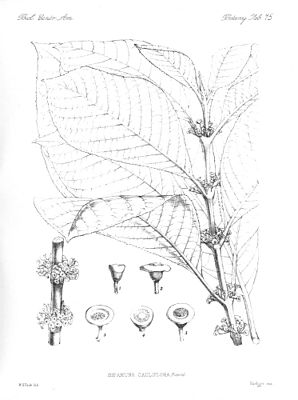Siparunaceae
| Siparunaceae | ||||||||||||
|---|---|---|---|---|---|---|---|---|---|---|---|---|

Siparuna cauliflora , illustration |
||||||||||||
| Systematics | ||||||||||||
|
||||||||||||
| Scientific name | ||||||||||||
| Siparunaceae | ||||||||||||
| ( A.DC. ) Schodde |
The Siparunaceae are a family of plants from the order of the laurel-like (Laurales). It contains only the Neotropical genus Siparuna and the African genus Glossocalyx .
description
Vegetative characteristics
The Siparunaceae are evergreen , woody plants and grow as shrubs , trees or lianas . The nodes are unilacunar with several leaf traces.
The opposite leaves can have glands. They are simple with an undivided blade and toothed or smooth leaf margin, the veins are feathery. The stomata are paracytic. Complex star and dandruff hair can be present. In the mesophyll there are round cells filled with essential oils . There are no stipules .
Inflorescences and flowers
The species are monoecious ( monoecious ) or dioecious ( dioecious ) separately sexed. The diocese has developed from the monocy three times within the family. The flowers are always strictly unisexual.
The mostly lateral, more rarely terminal inflorescences are spikes , panicles or cymes .
The structure of the flower envelope is interpreted differently. The most common is that the four to eight bracts that are in one or two whorls are sepals . In some species the bracts are completely fused together to form a kalyptra (lid), in others they are almost obsolete. In Glossocalyx , a bloom is enlarged to a long, flat, lanceolate tongue (hence the common name "tongue calyx").
The Androeceum consists in male flowers of (one) two to many (for example 2 + 2 + 2) stamens that are not fused and all fertile . The stamens have no nectar-producing attachments. The dust bags open with a flap. The pollen grains are nonaperturat.
The gynoeceum consists of four to many free or fused carpels . Some of these are subordinate, they are sunk into the fleshy hypanthium . The stylus is long. The stylus can be grown together. There is one ovule per carpel with basal placentation. The ovule is erect, anatropic, unitegmisch with a thick integument and crassinucellate.
Fruits and seeds
The fruits are small stone fruits with a red or orange aril . These are sunk into the fleshy, berry-like hypanthium , which opens with cracks when ripe. The seeds have an endosperm .
Sets of chromosomes
The basic chromosome number is x = 22.
evolution
In the neotropical species there is a connection between sex, leaf margin and occurrence: Diocesan species with smooth leaf margins occur in the lowlands, while monoeconomic species with serrated leaf margins occur in the mountains at altitudes above 700 meters. The lowland species are around four million years old and younger than the mountain clans (16 to 42 million years old).
Systematics and distribution


The family was established in 1970 by Richard Schodde . Alphonse Louis Pierre Pyrame de Candolle had placed the group as a tribe Siparuneae in the Monimiaceae family in 1868 . The sister group of the Siparunaceae within the order Laurales is the group from the families Gomortegaceae and Atherospermataceae .
The family Siparunaceae contains only two genera with at least 75 species:
- Siparuna Aubl. : The 50 to 150 species are common in the Neotropics from Mexico to Brazil.
-
Glossocalyx Benth. : It contains a type:
- Glossocalyx longicuspis Benth. : It occurs in a relatively small area in West Africa : Cameroon , Gabon and on the island of Fernando Pó .
The genera Bracteanthus Ducke and Conuleum A.Rich. are now in the genus Siparuna Aubl. incorporated.
Sources and further information
The article is mainly based on the following web links:
- The Siparunaceae family on the AP website. (Sections systematics and description)
- Siparunaceae in L. Watson and MJ Dallwitz (1992 onwards): DELTA - The families of flowering plants . (Section description)
- [1] An online key to all species of Siparunaceae and Monimiaceae occurring in Ecuador, with descriptions, specimen citations, geographic information, and illustrations of all species.
Individual evidence
- ↑ a b Susanne Renner, Hyosig Won: Repeated Evolution of Dioecy from Monoecy in Siparunaceae (Laurales). In: Syst. Biol. , Volume 50, Issue 5, 2001, pp. 700-712. PDF.
- ^ Richard Schodde: Two New SupAGENeric Taxa in the Monimiaceae Alliance (Laurales). In: Taxon Volume 19, 1970, p. 325. doi: 10.2307 / 1219055
- ^ ALP de Candolle: Prodromus Systematis Naturalis Regni Vegetabilis , 16, 2, 1868, pp. 641-642. Scanned in at botanicus.org .
- ↑ The Siparunaceae family on the AP website.
- ↑ Siparunaceae in the Germplasm Resources Information Network (GRIN), USDA , ARS , National Genetic Resources Program. National Germplasm Resources Laboratory, Beltsville, Maryland.
literature
- Susanne Renner, Hyosig Won: Repeated Evolution of Dioecy from Monoecy in Siparunaceae (Laurales). In: Syst. Biol. , Volume 50, Issue 5, 2001, pp. 700-712. PDF